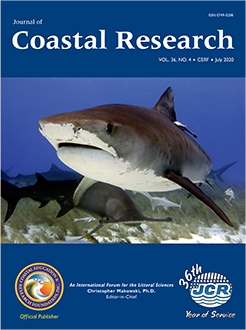Nguyen, T.H.T.; Park, S.W., and Ahn, J., 2020. Properties of rising multiple CO2 droplets under contamination of SO2: Understanding scenarios of leakage to seawater. Journal of Coastal Research, 36(4), 805–811. Coconut Creek (Florida), ISSN 0749-0208.
Research on impacts of impurities on the rising of liquid droplets in other liquids is still quite limited, especially when it comes to the behavior of multiple particles. The properties of rising multiple CO2 droplets under contamination of SO2 are investigated in a scenario in which they may leak to the seawater from a pipeline or facility in a Carbon Capture and Storage (CCS) project. The interaction between droplets and their rising properties such as velocity were examined. The results of numerical simulation show that the presence of SO2 changes particles' shape and their rising velocities significantly compared with the single droplet case. This SO2 contamination also caused the repulsion of impure particles even when they were placed close to each other, which was observed as coalescence in the pure CO2 case. Results will help in understanding the impacts of contamination on the rise of multiple CO2 droplets such as that leaked by future CCS operations.





